Welcome to our easy guide on how to calculate capacitors in parallel—a fundamental concept for anyone delving into the world of electronics. Whether you’re a beginner or looking to sharpen your skills, understanding how to calculate capacitors in parallel is essential for designing and analyzing circuits effectively.
In this guide, we’ll break down the process into simple steps, ensuring you grasp the basics of how to calculate capacitors in parallel with ease. By the end, you’ll confidently handle capacitor calculations and apply them to your projects with clarity. Let’s dive in!
What Is A Capacitor?
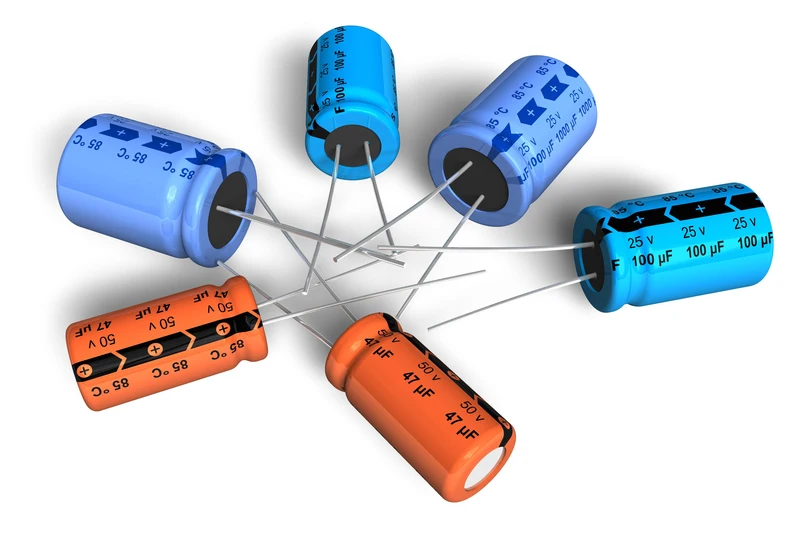
A capacitor is a fundamental electronic component designed to store and release electrical energy. It consists of two conductive plates separated by an insulating material called a dielectric. When a voltage is applied, the capacitor stores energy in the form of an electric field between the plates.
Capacitors are crucial in various electrical circuits, performing functions such as smoothing out voltage fluctuations, filtering signals, and stabilizing power supplies. Understanding capacitors is essential for tasks like how to calculate capacitors in parallel, where multiple capacitors are combined to achieve a desired total capacitance.
Whether you’re working on DIY electronics or designing complex circuits, knowing how capacitors function and how to calculate their values accurately is key to efficient circuit design.
What Is A Parallel Capacitor?
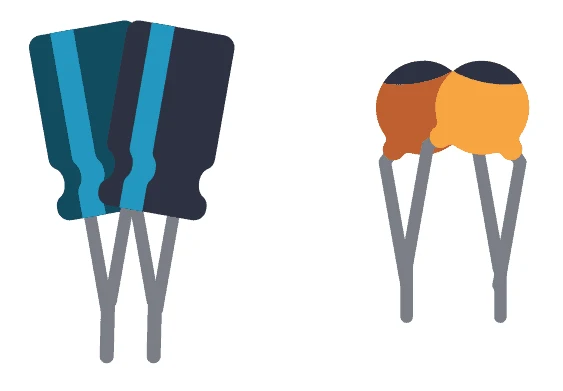
Parallel capacitors are connected side by side, sharing both their positive and negative terminals. This setup ensures that each capacitor experiences the same voltage. To calculate the total capacitance in parallel, simply add the individual capacitances together.
For instance, if you have capacitors of 4µF and 6µF, their total capacitance would be 10µF. This straightforward addition is the key to understanding how to calculate capacitors in parallel.
Why Calculate Capacitors In Parallel?
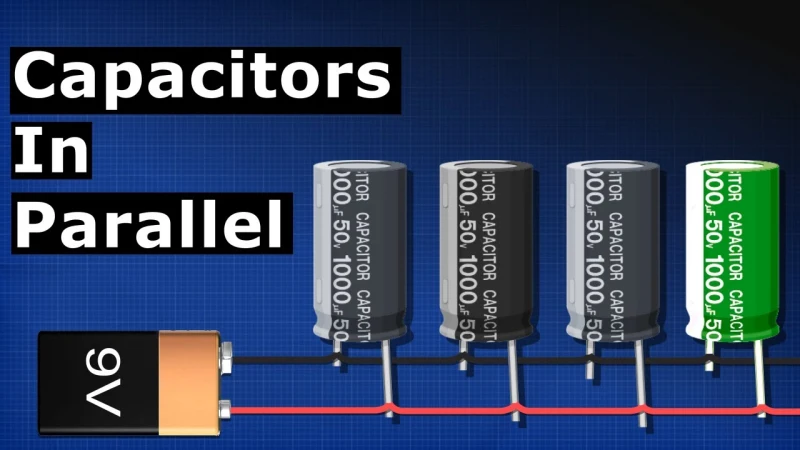
When designing or troubleshooting circuits, knowing how to calculate capacitors in parallel is crucial for optimizing performance.
Effects on Circuit Performance: Capacitors in parallel increase the total capacitance, enhancing the circuit’s ability to store charge and smooth out voltage fluctuations. This is vital for stable power supply and signal processing.
Benefits of Combining Capacitors: By combining capacitors in parallel, you can achieve a desired capacitance with available components, improve the circuit’s frequency response, and reduce equivalent series resistance (ESR), which can enhance overall efficiency.
Basic Formula For Capacitors In Parallel
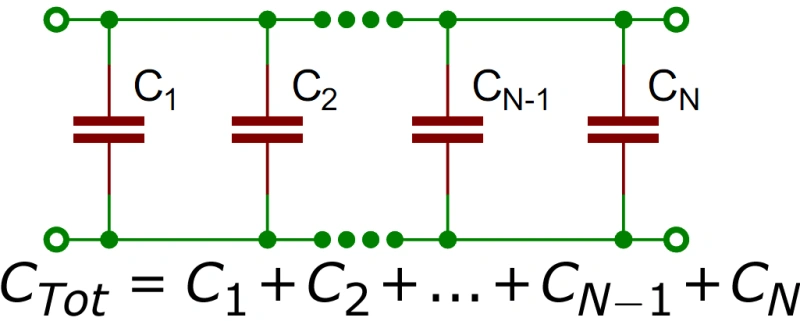
The basic formula for capacitors in parallel is used to determine the total capacitance when multiple capacitors are connected in parallel. In a parallel circuit, all capacitors experience the same voltage across them. The total or equivalent capacitance (Ctotal) is the sum of the individual capacitances. This means you simply add up the capacitance values of each capacitor:
Ctotal=C1+C2+C3+…..+Cn
where C1,C2,C3,…,Cn are the capacitances of the individual capacitors.
This formula highlights that in a parallel connection, the total capacitance increases as more capacitors are added, effectively increasing the circuit’s ability to store charge. This principle is useful in various electronic applications to achieve desired capacitance values.
How To Calculate Capacitors In Parallel?
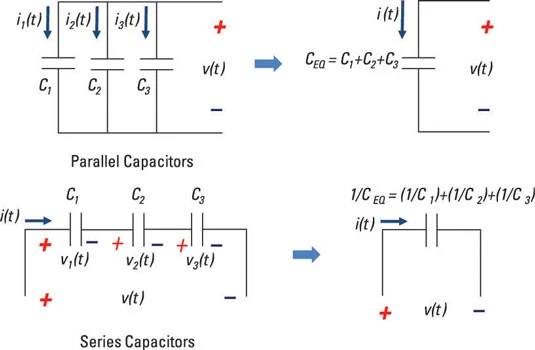
Calculating capacitors in parallel is essential for ensuring your circuit functions correctly. Here’s a detailed guide on how to calculate capacitors in parallel:
Step-by-Step Calculation:
Identify and List the Capacitance Values of Each Capacitor: Begin by determining the capacitance value of each capacitor in your parallel circuit. These values are typically marked on the capacitor body and are measured in farads (F). For example, you might have capacitors with values of 10 µF, 20 µF, and 30 µF.
Add the Values Together to Find the Total Capacitance: To find the total capacitance of capacitors in parallel, simply add the individual capacitance values together. The formula for this calculation is: Ctotal=C1+C2+C3+…
where C1,C2,C3,…are the capacitance values of the capacitors in parallel. Using the example values, the total capacitance would be: Ctotal =10μF+20μF+30μF=60μF. This total capacitance represents the combined ability of the capacitors to store charge and affect the circuit’s performance.
Example Calculation With Three Capacitors: Using the example values: Ctotal=4µF+6µF+10µF. Adding these values together: Ctotal=20µF. So, the total capacitance of the three capacitors connected in parallel is 20 µF. This simple method ensures that you accurately determine the combined capacitance, making it easier to design and analyze circuits.
How To Calculate Capacitors In Parallel:Practical Example
Real-World Application of Parallel Capacitors: In electronic circuits, capacitors are often used in parallel to increase the total capacitance and improve performance. For instance, in a power supply circuit, multiple capacitors might be used to filter and smooth out voltage fluctuations. By connecting capacitors in parallel, you can enhance the circuit’s ability to maintain a stable voltage.
Sample Problem and Solution: Suppose you’re designing a power supply filter and need to combine three capacitors to achieve a total capacitance of 30 µF. You have the following capacitors available:
Capacitor A: 10 µF
Capacitor B: 12 µF
Capacitor C: 8 µF
To find the total capacitance, use the formula for capacitors in parallel: Ctotal=CA+CB+CC
Substitute the given values: Ctotal=10µF+12µF+8µF
Adding these together: Ctotal=30µF
So, the total capacitance of the three capacitors connected in parallel is exactly 30 µF, meeting your design requirement. This practical example highlights how how to calculate capacitors in parallel allows you to effectively combine capacitors to achieve the desired electrical characteristics for your circuit.
Common Mistakes Of Calculate Capacitors In Parallel
When tackling how to calculate capacitors in parallel, it’s crucial to avoid common errors that can lead to inaccurate results. Understanding these mistakes can help ensure precise calculations and effective circuit design.
Incorrectly Using Series Formulas
One of the most frequent errors in calculating capacitors in parallel is mistakenly applying series formulas. In parallel circuits, the total capacitance CtotalC_{total}Ctotal is not calculated like in series circuits. Using the series formula for parallel capacitors will yield incorrect results, which can affect the performance of your circuit. Always ensure you are using the correct formula based on the circuit configuration.
Misreading Capacitance Values
Another common mistake is misreading or misinterpreting capacitance values. Capacitors are often marked with codes or colors that indicate their capacitance, but these codes can be confusing if you’re not familiar with them. For instance, a 10μF capacitor might be misread as 100μF due to a simple oversight.
To avoid this mistake, double-check the capacitance values using a multimeter if possible, and always verify against the manufacturer’s specifications. Accurate readings are crucial for proper calculations and ensuring the capacitors meet the requirements of your circuit.
Conclusion
In conclusion, mastering how to calculate capacitors in parallel is a straightforward yet essential skill for anyone delving into electronics. By simply adding the capacitance values of each capacitor together, you can determine the total capacitance with ease.
This method ensures that you can confidently work with capacitor configurations in your projects, whether you’re a beginner or a seasoned enthusiast. Understanding this basic principle will enhance your ability to design and troubleshoot electronic circuits effectively.
FAQ
How do capacitors behave when connected in parallel?
When capacitors are connected in parallel, their total capacitance increases. The total capacitance is the sum of the individual capacitances, meaning the overall capacitance is larger than any single capacitor in the group.
What is the benefit of connecting capacitors in parallel?
Connecting capacitors in parallel increases the total capacitance, allowing for greater charge storage and smoother voltage regulation in circuits. This is useful in applications requiring higher capacitance without using a single large capacitor.
How do I determine the total capacitance of multiple capacitors in parallel?
To find the total capacitance of capacitors connected in parallel, simply add the capacitance values of each capacitor together.
What happens to the voltage across capacitors in parallel?
In a parallel configuration, all capacitors share the same voltage. The voltage across each capacitor is the same as the voltage applied to the parallel combination.
Can I combine capacitors of different values in parallel?
Yes, capacitors of different values can be combined in parallel. The total capacitance will be the sum of the individual capacitances.
How does connecting capacitors in parallel affect their individual performance?
Each capacitor in a parallel arrangement will experience the same voltage, but the overall capacitance of the parallel combination will be higher. This can lead to improved performance in circuits that require higher capacitance.
Are there any practical considerations when connecting capacitors in parallel?
Ensure that all capacitors are rated for the same voltage to avoid damage. Additionally, keep in mind the physical space and layout when adding multiple capacitors in parallel.
What is the effect on the charge stored in capacitors when connected in parallel?
The total charge stored in capacitors connected in parallel is the sum of the charges stored in each capacitor individually, which is related to their total combined capacitance.
Do capacitors in parallel share the current equally?
No, capacitors in parallel do not necessarily share current equally. The current through each capacitor depends on its capacitance and the rate of change of the voltage.
How does temperature affect capacitors connected in parallel?
Temperature can affect the capacitance values of individual capacitors. When capacitors are connected in parallel, their combined capacitance may change with temperature variations, potentially affecting the overall performance of the circuit.